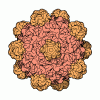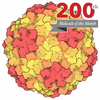+ Open data
Open data
- Basic information
Basic information
| Entry |  | |||||||||
|---|---|---|---|---|---|---|---|---|---|---|
| Title | The Red Crowned-Crane Parvovirus Capsid | |||||||||
 Map data Map data | ||||||||||
 Sample Sample |
| |||||||||
 Keywords Keywords | RCPV / Aveparvovirus / Parvovirus / capsid / VLP / cryo-EM / VIRUS | |||||||||
| Function / homology | Parvovirus coat protein VP2 / Parvovirus coat protein VP1/VP2 / Parvovirus coat protein VP2 / Capsid/spike protein, ssDNA virus / T=1 icosahedral viral capsid / structural molecule activity / Major capsid protein Function and homology information Function and homology information | |||||||||
| Biological species |  Red-crowned crane parvovirus Red-crowned crane parvovirus | |||||||||
| Method | single particle reconstruction / cryo EM / Resolution: 2.66 Å | |||||||||
 Authors Authors | Hsi J / Mietzsch M / McKenna R | |||||||||
| Funding support |  United States, 2 items United States, 2 items
| |||||||||
 Citation Citation |  Journal: J Virol / Year: 2025 Journal: J Virol / Year: 2025Title: Birds of a feather flock together: structural characterization of red-crowned crane and turkey aveparvoviruses. Authors: Jane Hsi / Mario Mietzsch / Matthew Patney / Sunny Chen / Anjelique Sawh-Gopal / Paul Chipman / Robert McKenna /  Abstract: The parvoviruses have non-enveloped = 1 icosahedral capsids that are ~25 nm in diameter, which package linear single-stranded DNA and infect a wide range of hosts. To date, parvoviruses affecting ...The parvoviruses have non-enveloped = 1 icosahedral capsids that are ~25 nm in diameter, which package linear single-stranded DNA and infect a wide range of hosts. To date, parvoviruses affecting birds have been identified in two genera: - and , and no capsid structures have been determined for any member of . This study investigates two bird viruses of this genus: red-crowned crane parvovirus (RCPV) and turkey parvovirus (TuPV). While the pathogenicity of RCPV is currently unknown, TuPV has been associated with gastrointestinal diseases, especially in juvenile birds. High-resolution structures of the RCPV and TuPV capsids were determined by cryo-electron microscopy at a resolution of 2.66 Å and 2.35 Å, respectively. A structural comparison of the RCPV and TuPV capsids shows that they exhibit many conserved features, such as a channel at the five-fold symmetry axis and surface depressions at the two-fold axis, as previously observed in parvoviruses from other genera. However, major structural differences were observed at the three-fold axes, with both RCPV and TuPV displaying recessed protrusions. In addition, terminal sialic acid was identified as a potential glycan receptor for RCPV. This study extends the architectural portfolio of structural parvovirology and will provide insights into parvoviral diversity and characterization of these viruses.IMPORTANCEThis study presents the capsid structures of two aveparvoviruses, red-crowned crane parvovirus (RCPV) and turkey parvovirus (TuPV), extending the structural repertoire of the . While the pathogenicity of RCPV is unknown, the red-crowned cranes are among the rarest crane species. To date, very few virological studies have been conducted for this rare avian species, and understanding their virome could contribute to conservation efforts. Additionally, several studies have previously suggested that TuPV is associated with cases of enteric disease syndrome. To date, no commercial antivirals or vaccines are available for TuPV. The structural characterization of its capsid may contribute toward the development of a treatment to control the spread of infection. | |||||||||
| History |
|
- Structure visualization
Structure visualization
| Supplemental images |
|---|
- Downloads & links
Downloads & links
-EMDB archive
| Map data |  emd_48926.map.gz emd_48926.map.gz | 441.9 MB |  EMDB map data format EMDB map data format | |
|---|---|---|---|---|
| Header (meta data) |  emd-48926-v30.xml emd-48926-v30.xml emd-48926.xml emd-48926.xml | 17 KB 17 KB | Display Display |  EMDB header EMDB header |
| Images |  emd_48926.png emd_48926.png | 130.1 KB | ||
| Filedesc metadata |  emd-48926.cif.gz emd-48926.cif.gz | 6 KB | ||
| Others |  emd_48926_half_map_1.map.gz emd_48926_half_map_1.map.gz emd_48926_half_map_2.map.gz emd_48926_half_map_2.map.gz | 186.5 MB 186.5 MB | ||
| Archive directory |  http://ftp.pdbj.org/pub/emdb/structures/EMD-48926 http://ftp.pdbj.org/pub/emdb/structures/EMD-48926 ftp://ftp.pdbj.org/pub/emdb/structures/EMD-48926 ftp://ftp.pdbj.org/pub/emdb/structures/EMD-48926 | HTTPS FTP |
-Validation report
| Summary document |  emd_48926_validation.pdf.gz emd_48926_validation.pdf.gz | 1.1 MB | Display |  EMDB validaton report EMDB validaton report |
|---|---|---|---|---|
| Full document |  emd_48926_full_validation.pdf.gz emd_48926_full_validation.pdf.gz | 1.1 MB | Display | |
| Data in XML |  emd_48926_validation.xml.gz emd_48926_validation.xml.gz | 18.3 KB | Display | |
| Data in CIF |  emd_48926_validation.cif.gz emd_48926_validation.cif.gz | 21.5 KB | Display | |
| Arichive directory |  https://ftp.pdbj.org/pub/emdb/validation_reports/EMD-48926 https://ftp.pdbj.org/pub/emdb/validation_reports/EMD-48926 ftp://ftp.pdbj.org/pub/emdb/validation_reports/EMD-48926 ftp://ftp.pdbj.org/pub/emdb/validation_reports/EMD-48926 | HTTPS FTP |
-Related structure data
| Related structure data |  9n5lMC  9n5mC M: atomic model generated by this map C: citing same article ( |
|---|---|
| Similar structure data | Similarity search - Function & homology  F&H Search F&H Search |
- Links
Links
| EMDB pages |  EMDB (EBI/PDBe) / EMDB (EBI/PDBe) /  EMDataResource EMDataResource |
|---|---|
| Related items in Molecule of the Month |
- Map
Map
| File |  Download / File: emd_48926.map.gz / Format: CCP4 / Size: 476.8 MB / Type: IMAGE STORED AS FLOATING POINT NUMBER (4 BYTES) Download / File: emd_48926.map.gz / Format: CCP4 / Size: 476.8 MB / Type: IMAGE STORED AS FLOATING POINT NUMBER (4 BYTES) | ||||||||||||||||||||||||||||||||||||
|---|---|---|---|---|---|---|---|---|---|---|---|---|---|---|---|---|---|---|---|---|---|---|---|---|---|---|---|---|---|---|---|---|---|---|---|---|---|
| Projections & slices | Image control
Images are generated by Spider. | ||||||||||||||||||||||||||||||||||||
| Voxel size | X=Y=Z: 0.72 Å | ||||||||||||||||||||||||||||||||||||
| Density |
| ||||||||||||||||||||||||||||||||||||
| Symmetry | Space group: 1 | ||||||||||||||||||||||||||||||||||||
| Details | EMDB XML:
|
-Supplemental data
-Half map: #2
| File | emd_48926_half_map_1.map | ||||||||||||
|---|---|---|---|---|---|---|---|---|---|---|---|---|---|
| Projections & Slices |
| ||||||||||||
| Density Histograms |
-Half map: #1
| File | emd_48926_half_map_2.map | ||||||||||||
|---|---|---|---|---|---|---|---|---|---|---|---|---|---|
| Projections & Slices |
| ||||||||||||
| Density Histograms |
- Sample components
Sample components
-Entire : Red-crowned crane parvovirus
| Entire | Name:  Red-crowned crane parvovirus Red-crowned crane parvovirus |
|---|---|
| Components |
|
-Supramolecule #1: Red-crowned crane parvovirus
| Supramolecule | Name: Red-crowned crane parvovirus / type: virus / ID: 1 / Parent: 0 / Macromolecule list: #1 / NCBI-ID: 2079601 / Sci species name: Red-crowned crane parvovirus / Virus type: VIRUS-LIKE PARTICLE / Virus isolate: SPECIES / Virus enveloped: No / Virus empty: Yes |
|---|
-Macromolecule #1: Major capsid protein
| Macromolecule | Name: Major capsid protein / type: protein_or_peptide / ID: 1 / Number of copies: 60 / Enantiomer: LEVO |
|---|---|
| Source (natural) | Organism:  Red-crowned crane parvovirus Red-crowned crane parvovirus |
| Molecular weight | Theoretical: 58.906148 KDa |
| Recombinant expression | Organism:  |
| Sequence | String: MAAADSSADA AVPMSDSPSG GGGGGGGGGI GESTGNWTCN TVWGKNSIIT NASRHCVCLT RDLDMYKAIG NKDNGLVFGT ENKTAWVGW STPWNYIDYN QMCVHFSPRD WQRLINTASK WRPRSVHIKI FNIQVIQKTT VSDGTQYSND LTGTIQIFAD A QGRYPKLL ...String: MAAADSSADA AVPMSDSPSG GGGGGGGGGI GESTGNWTCN TVWGKNSIIT NASRHCVCLT RDLDMYKAIG NKDNGLVFGT ENKTAWVGW STPWNYIDYN QMCVHFSPRD WQRLINTASK WRPRSVHIKI FNIQVIQKTT VSDGTQYSND LTGTIQIFAD A QGRYPKLL YPCQTTMMGP FPNHIYYLPQ YAYTTACDGP TSNQDINALL NTNSAFYCLD ESPSAMLRTG NEWSCHYTFD DD TGWVHNT RSTIPIFERA NPLYDTWQVD LRGNDALRGH FSSWRQPWLP GPVINMTDGT AAGANLNTMP GVDVGASYMG IVP GPPICR AENDKDEYLQ TFWTPKTIGQ NEGDVKNSQI NTSTAYKSQV PTGRLWEVNA RGQYKAASSQ GNVADQQWAG CIPG MIWDR RPATYFDPIW QEKPITDDSF MYVSQMGGCT VSGAPGHIFV KNTPKPTGTA NEYVDEYSTF TITVTMEWEY EPHSF SQWN NYKMISNNES SAQAYVGMCN ASGQYVLNHS AGQLPEMWIT KNLSRVN UniProtKB: Major capsid protein |
-Macromolecule #2: MAGNESIUM ION
| Macromolecule | Name: MAGNESIUM ION / type: ligand / ID: 2 / Number of copies: 120 / Formula: MG |
|---|---|
| Molecular weight | Theoretical: 24.305 Da |
-Experimental details
-Structure determination
| Method | cryo EM |
|---|---|
 Processing Processing | single particle reconstruction |
| Aggregation state | particle |
- Sample preparation
Sample preparation
| Buffer | pH: 7.4 |
|---|---|
| Vitrification | Cryogen name: ETHANE |
- Electron microscopy
Electron microscopy
| Microscope | JEOL CRYO ARM 300 |
|---|---|
| Image recording | Film or detector model: GATAN K3 (6k x 4k) / Average electron dose: 50.0 e/Å2 |
| Electron beam | Acceleration voltage: 300 kV / Electron source:  FIELD EMISSION GUN FIELD EMISSION GUN |
| Electron optics | Illumination mode: FLOOD BEAM / Imaging mode: BRIGHT FIELD / Nominal defocus max: 1.9000000000000001 µm / Nominal defocus min: 0.47000000000000003 µm |
 Movie
Movie Controller
Controller








 Z (Sec.)
Z (Sec.) X (Row.)
X (Row.) Y (Col.)
Y (Col.)




































